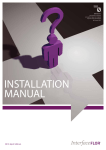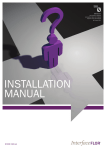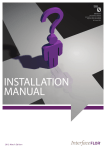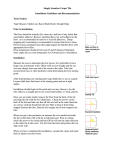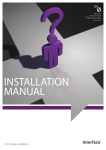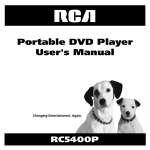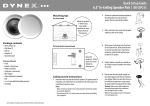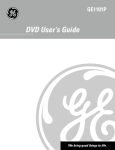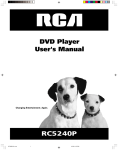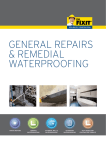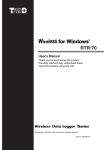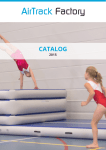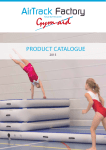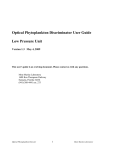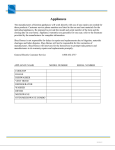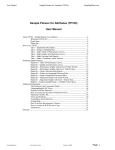Download INSTALLATION MANUAL
Transcript
INSTALLATION
MANUAL
2010 March Edition
Contents
01 BEFORE STARTING
page 3
02 CONDITIONING OF MATERIALS
page 3
03 FLOOR PREPARATION
page 3
04 INSTALLATION SET OUT
page 5
05 ANTI-SLIP COMPOUND – INTER-TAC®
page 7
06 Application of Adhesive
page 7
07 TacTile
page 7
08 TacTile placement
page 8
09TacTile subfloor preparation
requirements
page 9
10 UnderFLOOR Heating
page 9
11 Laying Direction
page10
12 Commencing the Installation
page10
13 Access Flooring
page11
14 Stairs
page11
15Installing Fixtures & Furniture
after Modular Carpet Installation
page11
16 Finish
page12
17 Conclusion
page12
18 CushionBac Modular Carpet
page12
19 Unbacked Sheet goods
page12
20 Installation over underlay
page13
System 6+ 1m x 1m Impervious System page14
Appendices
2
{
InterfaceFLOR Installation Manual
01 Concrete SubFLOOR Requirements
page 17
02INTERFACEFLOR INSTALLATION METHODS
AND CODES
page 18
Introduction
This manual has been prepared by
If InterfaceFLOR modular carpet
the InterfaceFLOR technical division
is installed before construction is
to assist professional contractors
complete, any resulting staining,
and layers in the installation of
soiling, contamination or damage
InterfaceFLOR modular carpet.
caused by building construction may
These instructions cover the most
common installation circumstances.
If a particular installation condition
is not covered, the contractor
void the end user’s product warranty.
The contractor should inform the
appropriate person of this warranty
implication.
should contact an InterfaceFLOR
representative.
Instructions
01 BEFORE STARTING
03 FLOOR PREPARATION
It is the responsibility of the contractor to verify, before the installation,
The subfloor must be rigid, dry, smooth, flat, level, sound, clean and
that material supplied conforms to owner’s specifications, including
free from harmful materials. When installing GlasBac® modular carpet
correct product, colour and quantity.
products, no bitumen based substance must come in contact with the
Labels on each carton contain important information including:
GlasBac backing.
product, colour and manufacturing batch (dye lot information).
The subfloor must be rigid to stop modular carpet from cupping.
It is not recommended to mix dye lots in the same area, with the
Old carpet, under felt, loose laid vinyl, cushion backed vinyl and any old
exception of the i2 collection of products as they possess mergable
adhesive must be removed and floor scraped clean.
™
dye lots.
A clean floor – Floor should be free from all dirt, dust and harmful
Take particular notice of installation codes printed on cartons as
materials. Before applying Intertac the subfloor should be swept
this indicates the manufacturers’ recommended installation method.
or vacuumed to remove all dust. Concrete or timber floors must be
However the client’s preferred installation method should be confirmed
primed with an approved primer such as Roberts 370 or Polymer 6000
and signed off by the installer before commencement of installation.
before application of Intertac.
A dry floor – All floors must be dry. New concrete floors must be
02 C
ONDITIONING OF
MATERIALS
checked for moisture as per AS2455 2007. Moisture content must
The installation location and all products and materials used in
before proceeding.
not exceed levels indicated in Appendix 1. If the moisture content
is above the recommended maximum readings STOP and DO NOT
PROCEED with the installation. Seek further advice from InterfaceFLOR
the installation, must be at temperature between 15 degrees C –
35 degrees C for a period of 48 – 72 hours before the installation
A low pH floor – The subfloor should have an alkalinity level of between
begins. The temperature must remain within this range throughout
pH7 & pH9 to be suitable for carpet installation. Test by wetting the
the installation. Relative humidity in the area should be 45% ± 10%.
floor with distilled water then using a pH test paper or meter. Should
the pH level be outside this range STOP and DO NOT PROCEED
with the installation. Seek further advice from InterfaceFLOR before
proceeding.
3
{
InterfaceFLOR Installation Manual
Identify the Type of Floor
New concrete floors – Must be smooth and level as per Appendix 1.
Old concrete floors – Remove paint, sealer, grease, oil, adhesive and any harmful materials,
especially bituminous based substances which are not compatible with GlasBac modular
carpet products. All existing adhesive must be removed from the floor. Fill and level all
cracks and holes. Bring surface up to specification as in Appendix 1 using an approved
latex levelling compound eg. Ardex K15 or equivalent, in accordance with manufacturer’s
directions. This levelling compound needs to be compatible with the backing system.
Any existing carpet, under felt, loose laid vinyl, cushion back vinyl and all existing adhesive
must be removed and the floor scraped clean.
Vinyl Tiles – Damaged & loose vinyl tiles must be replaced or patched and all existing wax
coated products are to be removed. Any existing bituminous based adhesive or underlay are
to be removed when installing GlasBac modular carpet products.
Ensure that the bond between vinyl tiles and subfloor will last the service life of the modular
carpet.
If a sealer is used, any reaction shall be the contractor and end-user’s responsibility.
Ceramic and quarry tiles – All joints are to be filled and levelled as per Appendix 1. Use rough
Sandpaper to remove surface glaze.
Wood Floors – Unless the subfloor is free from grooves, ridges, gaps, holes or similar
imperfections, the use of a hard underlay is recommended.
Underlay – The underlay should be either reduced density, as per AS2458 medium density
Note: When installing non impervious backed
floor coverings, water based adhesives, apart
from pressure sensitive adhesives, cannot be
used on a sealed floor.
fibre board types MDF and MDFMR in accordance with BS1142, or medium density fibrous
cement sheet known as hard underlay. The underlay and the fixing material must be
compatible with the InterfaceFLOR modular carpet and Inter-Tac adhesive. Installation shall
be in accordance with the underlay manufacturer’s instructions.
Sealer / Moisture Barrier – If a sealer is used on a concrete floor it must be compatible with
vinyl and can be either a solvent or water based sealer which can be acrylic, epoxy, urethane
or chlorinated rubber. Sealers must also be used in accordance with manufacturer’s
directions. If in doubt, coat sealer on back of the tile and leave overnight. It is not suitable
for use if it remains sticky.
An example of a suitable product to use for a hydrostatic moisture problem would be Ardex
WPM 300 Two Pack Epoxy or for a green slab – Ardex Green Slab Seal.
4
{
InterfaceFLOR Installation Manual
04 Installation Set Out
General
Note: Where practical there should
be uncut modular carpet tiles in door
ways and high traffic areas.
In setting up, a point in the room shall be determined from which modular carpet
can be laid to ensure that they are parallel to the longest wall.
Procedure
The procedure for setting out shall be in accordance with the following, as shown
in Figure 1.
Step 1
Mark a line EF parallel to the longest wall.
Step 2
Mark point X along line EF at a distance to ensue that the requirements
of perimeter modular carpet are a minimum of 1/3 width.
Figure 1
Step 3
Mark points J1 and J2 at a distance of 3 m each side of X.
Step 4
At J1 and J2 scribe an arc at a distance of 5 m to establish point K where
arcs intersect.
Step 5
Draw a line through points K and X which will be 90 degrees to line EF.
Single Room Installation
Figure 2
Step 1
Establish two chalk lines at 90 degrees as shown in Figure 1. This line may be
established slightly off centre to enable you to meet other requirements, such as
placing uncut modular carpet in traffic areas.
Step 2
Commencing only at the cross point of the two chalk lines, complete one row of
modular carpet on each side of the centre line.
Step 3
Anchor your basic installation as shown in Figure 2. Complete the body of the
installation by laying in a triangular method.
Step 4
Complete the remaining quadrants, section by section.
5
{
InterfaceFLOR Installation Manual
Large Area with Obstacles
Example: An Elevator
Step 1
Establish your starting point as shown in Figure 3a, with the A-B at 90 degrees.
Step 2
Pass your obstacle along line A and B with a minimum of 1 and 1/3 modular carpet.
Figure 3a
At this point you will establish line C and D, parallel to line B and A.
Step 3
Complete modular carpet between A and B. (Notice, only a single row of modular
carpet is used for this exercise).
Step 4
Continue to anchor your installation. Fill in the remaining quadrants as shown in
Figure 3b.
Office Complex
Figure 3b
Step 1
The crossover point, centre corridor, centre hall is the starting point for this
example as shown in Figure 4. Line A and B should again be at 90 degree angles.
Lay a row of modular carpet on each side along chalk line A. At the entrance
of each office passed, a chalk line is projected into that office at 90 degrees.
Complete your corridor including cutting.
Step 2
Lay the modular carpet into the offices and anchor the installation. This will create
line C parallel to line A. The total installation is lined out. Complete the body of
Figure 4
installation by laying in a triangular method as shown in Figure 3.
Step 3
Complete all cut modular carpet in the corridor, including door ways. Lay and anchor
modular carpet along line C. Fill in the remaining parts.
Borders
Set out chalk lines at the required distance for the border and/or field colour
modular carpet. Ensure all 90 degree angles are correct. Use these chalk lines as
wall lines and cut modular carpet up to these lines. Cut border modular carpet in
Figure 5
6
{
InterfaceFLOR Installation Manual
from chalk line to compensate for any irregularities in the wall. Refer to Figure 5.
05 Anti-slip Compound – Inter-Tac®
All InterfaceFLOR modular carpets require 100% application of Intertac unless
utilising TacTile or otherwise specified by manufacturer.
Note: If subfloor is an access floor that
is prone to rusting the use of TacTile is
recommended.
Intertac is a low odour, solvent free pressure sensitive adhesive containing
Intersept. (InterfaceFLOR anti-microbial additive)
The subfloor should be prepared to AS:2455 requirements.
An approved primer such as Roberts 370 or Polymer 6000 must be used on all
porous surfaces.
Before application of Intertac the subfloor should be vacuumed and washed to
remove all dust from the subfloor.
06 Application of Adhesive
Note: Tack off time will also be longer and
relevant to humidity in the work area and
general site conditions.
Note: A new long nap roller should be
used at the start of each installation.
Note: In certain conditions a stronger bond
to the subfloor may be required. For a
stronger bond the tile can be installed into
semi-tacked up Intertac adhesive allowing for
some adhesive transfer to occur.
Inter-Tac is a pressure sensitive compound. Application is by long nap paint roller.
Rate of application is 10m2 to 14m2 per litre, depending on the porosity of the
subfloor. On non-porous floors the rate of application will change and a spread
rate greater than 14m2 per litre may be obtained in some cases.
It is mandatory that Inter-Tac must tack up before use. Colour must change from
green to clear and it must not transfer.
Users assume all risk and liability resulting from the use of Inter-Tac. It is
recommended that users carry out project specific trials to confirm the suitability
and application of Inter-Tac.
Note: Tack off time will also be longer and relevant to humidity in the work area and
general site conditions.
Note: A new long nap roller should be used at the start of each installation.
Note: In certain conditions a stronger bond to the subfloor may be required. For
a stronger bond the tile can be installed into semi-tacked up Intertac adhesive
allowing for some adhesive transfer to occur.
07 TacTiles™
Note: When using TacTile in a Glasbac
installation the TacTile is usable for two
installations after which a new TacTile
should be used.
Note: When using TacTile in a Graphlar
installation the TacTile will require
replacement for each installation change.
Glasbac & GlasbacRE – TacTiles can be used in the installation of both GlasBac
and GlasBacRE carpet tile. To lift existing carpet tiles simply peel the carpet tile
from the TacTile and fit a new carpet tile to the existing TacTile.
Graphlar – TacTile can be used in the installation of Graphlar carpet tile. To lift
a Graphlar tile simply run a sharp knife along the tile edge and cut through the
TacTile. Leaving the existing TacTile adhered to the carpet tile backing, lift the
carpet tile from the floor and fit a new TacTile to the corner. The new Graphlar
carpet tile can then be installed.
TacTile can be installed directly over wood, ceramic, marble and stone floors with
minimum floor preparation as long as moisture and pH levels are within
InterfaceFLOR recommendations.
Once the installation is completed and then maintained in line with InterfaceFLOR
installation and maintenance recommendations TacTiles will be effective for the
life of the installation providing they are not removed or replaced.
7
{
InterfaceFLOR Installation Manual
Rolling Loads – TacTiles can be used under areas that will be subjected to normal
commercial rolling load applications. Eg: Castor Chair, Hand Trolleys or similar.
For areas that will be subjected to heavy rolling loads such as pallet trolleys, fork
Note: A TacTile must be applied under every
cut tile abutting the field tiles.
lifts, scissor lifts, etc, please contact InterfaceFLOR Technical Services for project
specific advice.
Ramps – TacTile is not recommended for use on ramped floor areas. The use of
Intertac pressure sensitive adhesive is recommended when installing modular tile
to ramped floor areas.
08 TacTile Placement
For Quarter Turn / Monolithic / Non Directional Installation methods
A TacTile should be placed under every corner of each tile across the installation
area and all cut tiles abutting the field tiles.
For Brick or Ashlar Installation methods
A TacTile should be placed on every other corner across the installation area and
all cut tiles abutting the field tiles.
Quarter-Turn / Monolithic / Non-Directional
Installation methods will require 4 TacTiles per
square metre
Brick or Ashlar Installation methods
will require 4 TacTiles per square metre
TacTiles should be applied based on the following diagrams.
TacTiles
Note: TacTiles are not recommended for installation of carpet tiles to stairs
Note: A TacTile must be applied under every cut tile abutting the field tiles.
Note: Glasbac & GlasbacRE Tile
TacTiles will be effective for the life of the installation providing they are not
removed or replaced.
Where carpet tiles are replaced TacTiles will only be effective for 2 installation changes
after which they need to be replaced to maintain the integrity of the installation.
Note: Graphlar Tile
TacTiles will be effective for the life of the installation providing they are not
removed or replaced.
Where carpet tiles are replaced TacTiles will require replacement for each
installation change to maintain the integrity of the installation.
8
{
InterfaceFLOR Installation Manual
09TACTILE Subfloor Preparation
Requirements
NOTE: If the subfloor exceeds the required
moisture and pH requirements the installation
of a barrier coat is recommended to prevent
future issues from rising moisture and pH.
Failure to carry out the correct subfloor
preparation or remedial works may result in
voiding of the product warranty.
The subfloor requirements for a TacTile installation are the same as for any
adhesive installation.
Please consult your InterfaceFLOR Installation manual for detailed recommendations.
TacTile can be installed directly over wood, ceramic, marble and stone floors
with minimum floor preparation as long as moisture and pH levels are within
InterfaceFLOR recommendations.
Notes on Subfloor Moisture and pH requirements
Moisture Content
Dependent on the testing method used the subfloor needs to be classified
as “DRY”
Test Methods
Calcium Chloride Test
Required to be measured in pounds of moisture over a 1000 ft2 area during a
24 hour period. An emission rate of 3.0 lbs. (1.4 kg) or less is acceptable
Hydrometer
Required to be 70% rh or less
Electrical Resistance Meter
Required to be 5.5% or less.
Subfloor pH requirement
The subfloor pH should be tested with a result of no more than pH 9.
10 Underfloor Heating
InterfaceFLOR modular carpet may be installed on internally heated floors provided
that the surface temperature will not exceed 27 degrees C.
Underfloor heating must be turned off 48 hours prior to commencement of
installation and shall not be turned on again until 48 hours after installation
is completed to allow the adhesive to set.
9
{
InterfaceFLOR Installation Manual
11 LayING Direction
All InterfaceFLOR modular carpets should be installed as per the directions printed
on the carton. Installation methods & codes printed on the cartons are:
DIR
Directional
QTRQuarter Turn
RDM
Random
SPEC
Specification Methods. (Refer to diagrams on inside back cover)
If SPEC code appears on the carton please confirm with the client their preferred
Note: All needle punch products must be
installed Quarter Turn.
installation method.
It is the installers responsibility to confirm the installation method prior to
commencement on installation.
12 Commencing the Installation
Apply Inter-Tac as recommended. Lay one row of modular carpet down each side
of the chalk line, then install the modular carpet using the stair method. This will
quickly pin point if the grid is running out of alignment.
Alignment
As modular carpet is butted against each other, continually check (with fingers)
that the joints are properly aligned. Do not install modular carpet that is out of
square by more than 1mm.
Tension
Ensure an even tension throughout the installation as this is vital to the overall
appearance.
Lack of tension and pile entrapment may cause poor performance and will impair
the appearance of the finished installation.
Over tension of the installation may cause peaking of the tile.
The cumulative space gained in GlasBac or Graphlar® modular carpet products
should be 5mm, measured over 11 modular carpet squares (10 joins). Any gain
less than this may cause peaking and or buckling.
Cutting
All InterfaceFLOR modular carpet must be cut from the backing side by overlaying
NOTE: Modular carpet cut on an angle or a cut
edge that is exposed to heavy foot or wheeled
traffic may need to be sealed with latex.
the modular carpet, marking and cutting. A template should be used around
columns.
Step 1 Firstly effect a light cut without attempting to cut right through.
NOTE : When abutting InterfaceFLOR carpet up
to a hard surface finish or edge trim the top
of the carpet pile should be level with the top
of the hard surface or edge trim. If the carpet
pile sits higher than the hardsurface or edge
trim and is exposed to high levels of traffic
this may cause damage to the carpet edge.
10
{
InterfaceFLOR Installation Manual
Step 2 Then crack the modular carpet along the line cut.
Step 3 C
omplete by cutting right through the fibres with a straight utility or hook knife.
13 Access Flooring
On Grid Access Flooring Installation –
GlasBac®OG 600 x 600mm modular carpet
The installation of GlasBacOG differs from traditional on grid carpet laying in
that you do not butt up the tiles to each other. Instead, installation is by placing
the modular carpet locating buttons (attached to the backing) into the matching
positioning holes on the access panel. Inter-Tac adhesive is not required. The
locating buttons limit movement of tiles on the access panels.
Off Grid Access Flooring Installation –
500 x 500mm modular carpet
Note: On access floors an application rate for
Intertac of over 14 m2 may be achieved in some
cases.
On access floors, off grid installation will mean that the edge of the
modular carpet does not correspond with access floor panel joints.
Installation as per standard InterfaceFLOR modular carpet installation instructions.
Intertac adhesive and TacTile are both suitable for modular tile installation over
access flooring.
On access floors an application rate for Intertac of over 14m2 may be achieved in
some cases.
14 Stairs
Stairnosing
Note: It is important to bring the modular
carpet right up to the underside of the nosing,
flush with the tread, as this will support
the leading edge of the nosing and prevent
it rocking and coming loose. Do not bend
modular carpet over the edge of stair steps.
InterfaceFLOR modular carpet cannot be installed over the nose of a stair.
A metal or rubber nosing must be installed.
Riser
Apply Inter-Tac to both the tile backing and the riser.
Allow Inter-Tac to tack up and place carpet for the riser in position.
Tread
Apply Inter-Tac to 100 per cent of tread.
The tread should be fitted after the riser to allow the tread carpet to hold the riser
securely in position.
15Installing Fixtures &
Furniture after Modular
Carpet Installation
To avoid dislodging modular carpet during furniture and fixture placement, place
standard sheets of plywood or cardboard over the complete installation.
If plastic type protection is used, any condensation is the responsibility of the
contractor. Do not position adhesive tape on pile of modular carpet.
11
{
InterfaceFLOR Installation Manual
16 Finish
Edge Restraint – In the event of an open perimeter area a fixed reducer strip
It is recommended that all 12th gauge
products be checked thoroughly for tuft
sprouts and that any noticeable sprouts are
napped as part of the finishing procedure.
anchored to the floor is recommended. The edge restraint should be the same
height as the carpet and finish level with the carpet pile ensuring a smooth
transition from one surface to the other.
Nap all slivers and tuft sprouts using napping shears.
It is recommended that all 12th gauge products be checked thoroughly for tuft sprouts
and that any noticeable sprouts are napped as part of the finishing procedure.
Apply a final Vacuum or Pile Lifting process.
Ensure that the overall finished appearance is consistent throughout. Correct any
defects including incorrect arrow direction.
Upon completion, a further vacuum or pile lift may be required. It is essential that
lighting be in service to allow inspection under good lighting conditions.
17 Conclusion
These installation procedures are recommended by the manufacturer and
installation should only be carried out by experienced and competent carpet
Any variance from any of these
instructions will become the responsibility
of the contractor and not the manufacturer
and shall void all other wise applicable
warranties.
installers. Strict adherence to these procedures will result in a quality installation
under most conditions. Any situation that can alter the installation procedure, such
as the identification of defect material or unusual installation conditions, creates
a responsibility for the contractor to notify both the owner and the manufacturer
before proceeding.
Any variance from any of these instructions will become the responsibility of the
contractor and not the manufacturer and shall void all other wise applicable warranties.
18InterfaceFLOR CushionBac™
Modular Carpet
Follow the same procedure as outlined for InterfaceFLOR modular carpet.
19InterfaceFLOR Sheet Goods
– Unbacked
Apply 100% adhesive such as Roberts 95SF or Polymer 300. If installing to areas
that will be subjected to excessive steam cleaning, ie.; hotel bar areas, gaming
rooms etc., use adhesive such as Roberts 12SF or Polymer 365.
12
{
InterfaceFLOR Installation Manual
20 Installation over underlay
Bridgestone Airstep ‘SuportaPad’ or Dunlop ‘Modulay’
Underlays
Prepare floor as outlined in Section 3, ensuring floor is primed using a product such
as Roberts 370 or Polymer 6000 Primer.
Adhesion of Underlay to Subfloor
1Before use, the underlay should be removed from its plastic packaging and fully
unrolled for a period of no less than four hours. It is preferable that the product
be left unrolled overnight.
Decide the position of the datum lines for alignment of modular carpet and offset
the starting seam of the underlay by 200mm from this line.
2The underlay should be bonded firmly to the subfloor with a product such as
Roberts 656, using a 1.6mm x 1.6mm “V” notched trowel. For example, Roberts
Switchblade V1.
3The underlay should then be lowered into the adhesive when “tack up” is evident
and rolled with a roller of no more than 25 – 30 kgs. This ensures the underlay
is secured to the subfloor. All joins must be close fitting when positioned and
excessive rolling should be avoided to allow curing of the adhesive.
Adhesion of InterfaceFLOR Modular Carpet
1On the surface of the underlay follow the procedure as outlined in Section 4 for
the Set Out using a pencil or waterproof marker.
Note: Adhesive spread rate will be
approx 5m2 per litre.
2Apply Roberts 656, or the equivalent adhesive, to the surface of the underlay
using a 1.6mm x 1.6mm “V” notched trowel and allow to dry per manufacturer’s
specifications before laying carpet into adhesive. In some conditions an air
mover may be required to assist with tack up time.
3 Commence installing modular carpet as outlined in Section 8.
4 Roll completed installation using a roller no more than 25-30 kgs.
5Finishing should be carried out in accordance with AS/NZS 2455.2 2007
Textile Floor Coverings – Installation Practice Part 2 Carpet Tiles and
in line with the Manufacturer’s printed instructions.
13
{
InterfaceFLOR Installation Manual
System 6+ 1m x 1m Impervious System
Installation
Methods
The installation of 1m x 1m tile to provide a moisture impervious installation can be
carried out in the following installation methods:
Intertac
Utilising Intertac adhesive to hold the tiles in position and seam sealing of the
carpet tiles to each other to provide impervious seams.
Freelay
Freelay of the tile utilising the seam sealer to provide both impervious seams and
also to hold the tile in position.
Description of each method as follows -
Option one – Intertac Installation method
1Apply InterfaceFLOR Floor Sealer as per recommendations.
NoteS: Any seam sealer that gets onto the
yarn or tile face should be immediately
removed.
While still wet the seam sealer can be
removed with water.
When dry will require a solvent based
seam sealer cleaner.
2Vacuum / sweep the subfloor.
3If InterfaceFLOR Floor Sealer is not being used the subfloor should be primed
with an acrylic based floor primer.
4Set out the grid line for the 1m x 1m tile.
5Apply Intertac as per recommendations set out in the InterfaceFLOR Installation
Manual.
6Once the Intertac has tacked up install your first tile to the grid line.
7Apply a 3mm bead of seam sealer to the tile edges being careful to only apply
seam sealer to the tile backing and not the yarn.
8Install the next tile by sliding the new tile into the already installed tile being
careful not to force seam sealer up onto the yarn.
9Follow this procedure for the balance of the area.
Note: Any seam sealer that gets onto the yarn or tile face should be immediately
removed.
Note: While still wet the seam sealer can be removed with water.
Note: When dry will require a solvent based seam sealer cleaner.
14
{
InterfaceFLOR Installation Manual
Option Two – Freelay Installation method
1Apply InterfaceFLOR Floor Sealer as per recommendations.
Notes: Any seam sealer that gets onto the
yarn or tile face should be immediately
removed.
2Vacuum / sweep the subfloor.
3Set out the grid line for the 1m x 1m tile.
While still wet the seam sealer can be
removed with water.
4Install your first tile to the grid line.
When dry will require a solvent based
seam sealer cleaner.
5Apply seam seam sealer to the tile edges being careful to only apply seam sealer
to the tile backing and not the yarn.
6Install the next tile by sliding the new tile into the already installed tile being
careful not to force seam sealer up onto the yarn.
7Follow this procedure for the balance of the area.
Note: Any seam sealer that gets onto the yarn or tile face should be immediatley
removed.
Note: While still wet the seam sealer can be removed with water.
Note: When dry will require a solvent based seam sealer cleaner.
InterfaceFLOR Floor Sealer
InterfaceFLOR Floor Sealer is a water based modified acrylic compound for sealing
concrete and other cementitious compounds.
When dry it cures to from an impervious film and displays excellent long term
resistance to urine, water, blood and most common chemicals.
It complies with ASTM D 1308-87 for the resistance to urine.
Floor Sealer Application method
The sealer can be applied to all clean, sound concrete or cementitious substrates.
1Remove all grease or grime with an alkaline cleaner.
2Wash the area and allow to dry for 24 to 48 hours.
3Should the subfloor show signs of laitence (loose surface concrete) this should
be removed by shot blasting or similar mechanical means.
4Any previous coatings or curing compounds to be removed as surface must be
porous.
5Subfloor and ambient air temperature must be above 10 degrees C.
6Sweep and vacuum all dust from the subfloor.
7Apply one coat of the sealer to the subfloor with roller, spray or brush ensuring
that all floor area is covered.
Covered areas can be easily recognised as the sealer has a light blue tinge.
15
{
InterfaceFLOR Installation Manual
8Allow first coat of the sealer to dry for 5 hours.
9 Apply a second coat of the sealer and allow to dry for 24 hours before
application of adhesive.
Note: In areas where a fully sealed floor
covering is installed the use of InterfaceFLOR
Floor Sealer is not obligatory.
10 If installing 1m x 1m tile without Intertac the installation can commence
once the InterfaceFLOR Medical Floor Sealer has touch dried which in most
conditions will be 30 to 60 minutes.
Note: In areas where a fully sealed floor covering is installed the use of
InterfaceFLOR Floor Sealer is not obligatory.
InterfaceFLOR Seam Sealer
InterfaceFLOR Seam Sealer is a high strength water based seam sealing adhesive
designed to provide a moisture impervious seam.
Seam Sealer Application method
1Installation temperature of working area and substrate is to be a minimum of
10 degrees C and a maximum of 30 degrees C.
2Carpet edges must be clean & dry.
3Starting at one end of the seam apply a 3mm continuous bead to the base of
the carpet tile backing ensuring no sealer is on the yarn.
4Slide the next tile into the seam while the seam sealer is still wet ensuring that
no seam sealer is forced up onto the yarn.
5Remove any excess wet seam sealer with water on a clean damp cloth.
6Allow seams to fully dry for 24 hours before allowing traffic.
Seam Sealer Maintenance Requirements
1If spillage on the seam occurs, prevent any traffic on the seam until the spillage
has been cleaned and fully dried.
2Do not allow spillage to remain on the seam for more than 48 hours.
3Only water-based cleaners should come into contact with the seam.
16
{
InterfaceFLOR Installation Manual
Appendices
01Concrete Subfloor
Requirements
1 Construction
Concrete subfloor shall be finished off true to grade and in accordance with good
building practice and shall be free from rising moisture as per AS2455-1995.
2 Surface
(a) Planeness
When a straight edge 3m long is placed on the surface at any position, no part of
the surface is more than 5mm above or below the straight edge.
(b) Smoothness
When straight edge 150mm long is placed on the surface position, no part of the
surface shall be more than 1 mm below the straight edge.
(c) Finish
New concrete floors shall be steel troweled to a smooth surface but not to a glass
finish. They shall be free from score marks, grooves, depressions and scraped free
of foreign materials.
3 Dryness
Before installation commences, the dryness of subfloor should be determined.
For InterfaceFLOR and Heuga modular carpet the moisture content shall not exceed
5.5 per cent, using a moisture unit. If a hydrometer is used, reading should not
be greater than 70 per cent at 15 degrees C or above. If the moisture content is
above the recommended maximum readings STOP and DO NOT PROCEED with
the installation. Seek further advice from InterfaceFLOR before proceeding.
4 Cleanliness
Before installation begins, foreign materials such as grease, oil, paint, existing
floorcovering and any other harmful materials, should be removed. Any surface
treatment or old adhesive that will effect the new adhesive or the holding power
of the modular carpet should be treated or removed. The floor shall be vacuumed
and washed to ensure a perfect bond.
5 Porosity
All concrete floors or floors that have been filled using a levelling compound should
be sealed using a sealer compatible with the backing system.
6 Alkalinity
The subfloor should have an alkalinity level of between pH7 & pH9 to be suitable
for carpet installation. Test by wetting the floor with distilled water then using
a pH test paper or meter. Should the pH level be outside this range STOP and
DO NOT PROCEED with the installation. Seek further advice from InterfaceFLOR
before proceeding.
17
{
InterfaceFLOR Installation Manual
02InterfaceFLOR Installation
Methods and Codes
DIRECTIONAL Installation – Code DIR
An arrow is printed on the back of each modular tile to indicate pile direction.
Make sure the arrows point in the same direction throughout your installation.
QUARTER TURN Installation – Code QTR
In this case, the arrows should be turned 90 degrees every other modular tile.
RANDOM Installation – Code RDM
This pattern allows installation of modular tiles without regard to arrow direction.
ASHLAR Installation
This pattern is created by offsetting the side joins of the modular tiles. All arrows
should point in the same direction.
BRICK Installation
This pattern is created by offsetting the front and back joins of the modular tiles.
All arrows should point in the same direction.
Code SPEC – Specification Methods can represent either: Directional, Quarter Turn, Ashlar or Brick Installation.
The codes printed on the cartons indicate the manufacturers’ recommended installation method. However it is the installers’
responsibility to confirm the clients’ preferred installation method prior to commencement of installation.
18
{
InterfaceFLOR Installation Manual
Contacts
Australia
Interface Aust Pty Limited
Phone: 02 8332 2400
Fax: 02 9318 1996
Email:
[email protected]
Web:
www.interfaceflor.com.au
For urgent installation, cleaning and maintenance
enquiries call 1800 785 277
New Zealand
InterfaceNZ Ltd
Phone: 0800 800 656
®Interface, InterfaceFLOR, Intersept and GlasBac are registered
trademarks of Interface Inc.
®InterTac is a registered trademark of Interface Aust Pty Limited.
®Airstep is a registered trademark of Bridgestone Australia Ltd.
™ i2 is a trademark of Interface Aust Pty Limited.
PN: 1905001
Email:
[email protected]
Web:
www.interfacenz.com



















